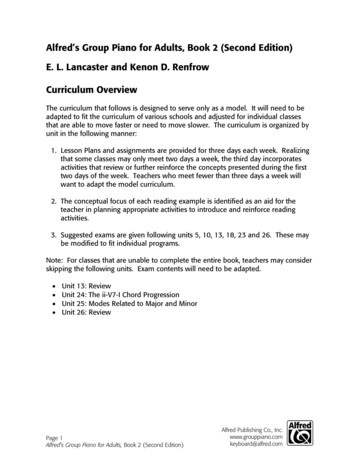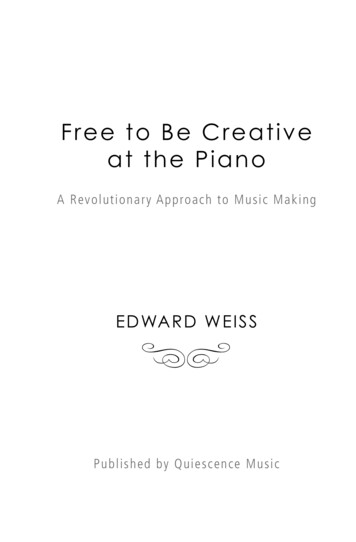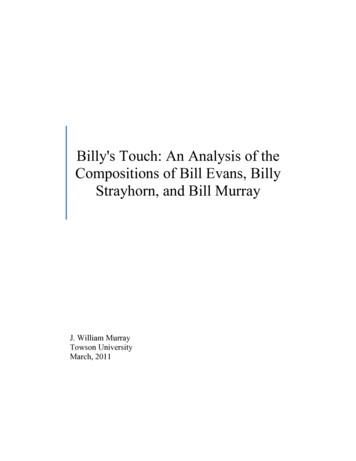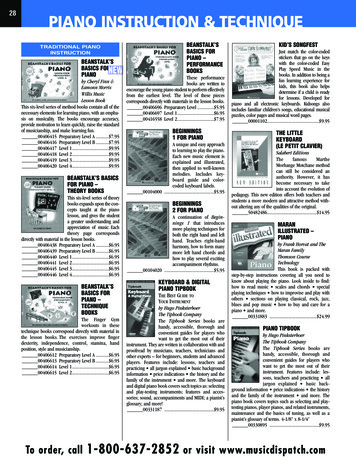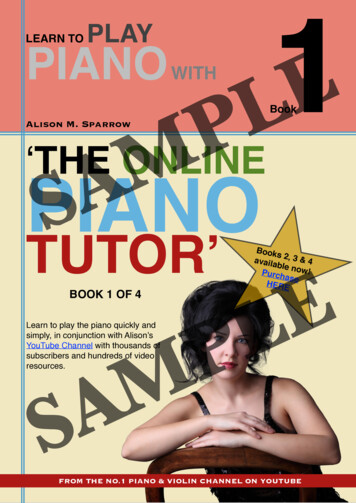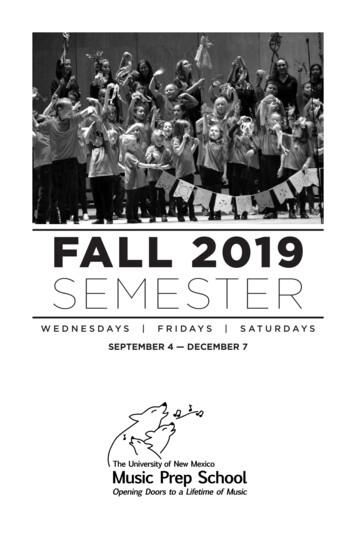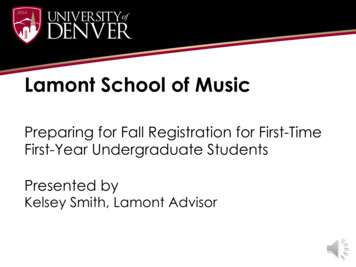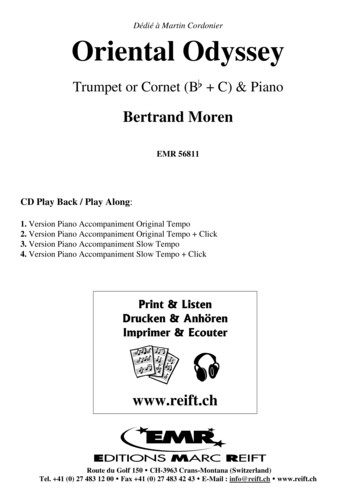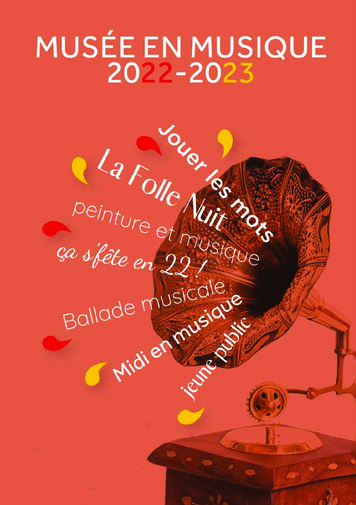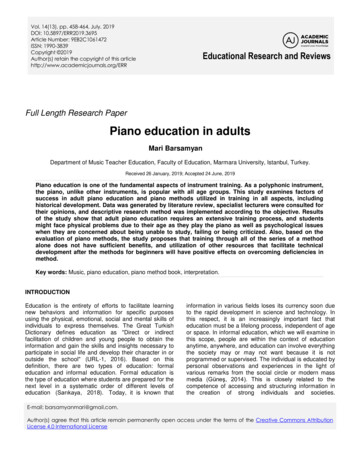
Transcription
Vol. 14(13), pp. 458-464, July, 2019DOI: 10.5897/ERR2019.3695Article Number: 9EB2C1061472ISSN: 1990-3839Copyright 2019Author(s) retain the copyright of this nal Research and ReviewsFull Length Research PaperPiano education in adultsMari BarsamyanDepartment of Music Teacher Education, Faculty of Education, Marmara University, Istanbul, Turkey.Received 26 January, 2019; Accepted 24 June, 2019Piano education is one of the fundamental aspects of instrument training. As a polyphonic instrument,the piano, unlike other instruments, is popular with all age groups. This study examines factors ofsuccess in adult piano education and piano methods utilized in training in all aspects, includinghistorical development. Data was generated by literature review, specialist lecturers were consulted fortheir opinions, and descriptive research method was implemented according to the objective. Resultsof the study show that adult piano education requires an extensive training process, and studentsmight face physical problems due to their age as they play the piano as well as psychological issueswhen they are concerned about being unable to study, failing or being criticized. Also, based on theevaluation of piano methods, the study proposes that training through all of the series of a methodalone does not have sufficient benefits, and utilization of other resources that facilitate technicaldevelopment after the methods for beginners will have positive effects on overcoming deficiencies inmethod.Key words: Music, piano education, piano method book, interpretation.INTRODUCTIONEducation is the entirety of efforts to facilitate learningnew behaviors and information for specific purposesusing the physical, emotional, social and mental skills ofindividuals to express themselves. The Great TurkishDictionary defines education as "Direct or indirectfacilitation of children and young people to obtain theinformation and gain the skills and insights necessary toparticipate in social life and develop their character in oroutside the school" (URL-1, 2016). Based on thisdefinition, there are two types of education: formaleducation and informal education. Formal education isthe type of education where students are prepared for thenext level in a systematic order of different levels ofeducation (Sarıkaya, 2018). Today, it is known thatinformation in various fields loses its currency soon dueto the rapid development in science and technology. Inthis respect, it is an increasingly important fact thateducation must be a lifelong process, independent of ageor space. In informal education, which we will examine inthis scope, people are within the context of educationanytime, anywhere, and education can involve everythingthe society may or may not want because it is notprogrammed or supervised. The individual is educated bypersonal observations and experiences in the light ofvarious remarks from the social circle or modern massmedia (Güneş, 2014). This is closely related to thecompetence of accessing and structuring information inthe creation of strong individuals and societies.E-mail: barsamyanmari@gmail.com.Author(s) agree that this article remain permanently open access under the terms of the Creative Commons AttributionLicense 4.0 International License
BarsamyanStructuring a society of individuals of lifelong learningcould undoubtedly be possible through the regulation ofeducation systems.Art education helps people of all ages become social,creative, productive and confident. The information andbehavior people gain help them succeed in theirprofessional lives and make the right decisions in sociallife, and establish creative and healthy relationships thatare open to improvement.Music training is one of the primary areas that supportlifelong learning because music is one of the chiefelements of common culture everyone needs to gain. Asa basic expression of human emotion, music is one of themost important and powerful educational tools. Accordingto famous Greek philosopher Plato, music is not onlyaimed at entertainment and its main function is to instillgood ethics and build a good character (Demirgen and Esin,2016). Undoubtedly, societies consisting of individualstrained in music also develop their cultural structure.Many students opt for piano in instrument training as itrequires less effort as a beginner compared to string andwind instruments, sounds are ready to use on thekeyboard, and it is possible to get different colors bypressing the keys in different techniques. Thefundamental skills instructors must teach their students atthe start of piano education should be correct handposition, a solid sense of rhythm and the ultimate goal ofovercoming technical problems and achieving a musicalinterpretation. It is important to choose the right approachand method to reach this goal and get the best outcomethat will satisfy instructors and students. Method isimportant to teach these behaviors at the desired level.Method books are books of effective and constantlearning, prepared to gradually teach how to play aninstrument in stages. In his study on "Choosing abeginner's method book in piano education," Eroğlu(2018) mentions the gradual development and change ineducation and teaching methods, and notes thattraditional teaching methods give way to contemporarymethods. Therefore, according to Eroğlu, piano methodsbased on contemporary teaching methodologies replaceolder methods. Also, studies show that students withintrinsic motivation, which can be described as the joy ofplaying the piano, are more successful (Özmenteş,2013). Certain studies on the cognitive, affective andpsychomotor factors that influence achievement in pianoeducation note that it is necessary to eliminate thetension stemming from concerns and preserve a healthyphysical structure by warming up before studying amusical work in order to achieve good performance onthe piano.ProblemThere is change and development in art and music inparallel with the changing and developing world.Adaptation to these developments is a measure of459modernization in our time. In this context, instrumenttraining can be regarded as a requisite for modernization(Orhan and Ercan, 2012). As there are few studies onadult piano education, the necessity of evaluating thesubject and methods used to train adults constitutes theproblem of this study.Objective of the studyThe study aims at analyzing adult piano education.Answers are sought to the following questions:1) What are the historical aspects of adult pianoeducation?2) Which methods are used in adult piano education?3) What are the factors of success in adult pianoeducation?Significance of the studyThe significance of this study lies in the identification ofproblems encountered by piano students and theguidance provided for instructors in the form ofsuggestions. Also, the study stresses that familiesfacilitate social and cultural development by directingtheir children to play an instrument.METHODOLOGYThis study discusses the factors of success in adult pianoeducation, historical aspects of adult piano education, and thepiano methods used in training according to the objective of thestudy. This qualitative study employs data collection methods ofobservation, professional experience, opinions of lecturers, andliterature review.FINDINGSFindings on the historical aspects of adult pianoeducationThe earliest method written for keyboard instruments wasa 3-part method titled "Fundamentum Organisandi",written in 1452 by Conrad Paumann, an organist wholived between 1410 and 1473. This was actually a bookon counterpoint.The earliest real method that contained methodologicaland pedagogic approaches originated in Spain. A friarnamed Thomas de Santa Maria presented a methodtitled "Arte de Tanor Fantasia" in 1565 after 16 years ofwork. The first volume of the 400-page book includesbasic knowledge as well as practical examples, whichwere rarely seen in those times. Chapter 13 of the firstvolume discusses eight important attributes of good work.(i) Playing at the correct rhythm
460Educ. Res. Rev.(ii) Correct hand position(iii) Correct sitting position on the piano(iv) Playing a clear and precise interpretation(v) Comfort with faster and slower passages(vi) Playing with correct fingering(vii) Considering the enjoyment of the audience(viii) Achievement in ornamentation of the musical workLater on, according to Böhnova, French composer F.Couperin (1668-1733) mentioned almost identical trainingapproaches in his method titled "Pieces de Clavcin." It isthusly understood that the foundation of the methodsused today were laid down about 200 years prior to theinvention of the piano.The attempts to program piano education date back tothe piano methods of composers like D.G. Turk (17891802), F. Kalkbrenner (1788-1849) and L. Köhler (18201886) since the invention of piano in 1711 (Eren, 2013).Authors of Oxford Piano Course (1928) published "TheBeginner's Book of Older Pupils" for adult students in1929. Contents of this method were designed to adapt toa more conceptual and quicker learning by maturestudents. Following these methods, "The Adult Explorerat the Piano," written by Ahean, Blake and Burrow andpublished in 1937, stressed on functional skills that willallow students to incorporate music into their daily livesand recognize it as a pleasant way of self-expression inaddition to keyboard education, playing musical worksand education. Later on, The Adult Preparatory Book(1943) by Thompson, "Adult Piano Course" by Aeron(1947) and "The Older Student" by Richter (1956)contained an introduction to the "middle c" system,traditional melody arrangements, folk tunes and sometechnical information.A historical review of piano methods shows thatthmethods published from the first half of the 20 centuryonwards started featuring basic elements of music, suchas music theory, sight-reading, accompaniment andcomposing skills (Uszler and Mach, 1991).Findings on the methods used in adult pianoeducationInstrument method books are prepared to help studentslearn how to play an instrument in a system of phasedprogress. Music training requires serious and detailedwork for professionals and amateurs alike. Within thecontemporary definition, the important thing is that themethod is consistent and gains international approvalwith the outcome of its application (Say, 2002). To benefitstudents, a piano method should:(i) Be appropriate for the age group, physical andpsychological state of the student(ii) Spark interest and encourage students to study(iii) Be compatible with phased progress(iv) Help the student gain technical skills(iv) Be suitable for modern education and teaching(v) Develop the student's musicality(vi) Include creative work like improvisation along withtheoretical informationThe most frequently used methods in adult pianoeducation are:(i) “The Older Beginner Piano Course” Level 1 and 2 byJames Bastien(ii) John Thompson’s Adult Piano Method Level 1 and 2(iii) Hal Leonard Adult Piano Method Level 1 and 2(iv) Burkard Piano Method(vi) Nancy Randall Faber Adult Adventure All-in-one 1, 2(v) Alfred Basic Piano Course All-in-one Course Level 1,2 and 3Instructors in Turkey have written several methods forbeginner piano students. In these methods, it is observedthat instructors include their own compositions as well asthe works of other composers. However, the samecannot be said of adult methods. Other thancompilations, there is unfortunately no piano methodstructured for adults. Therefore, traditional Turkish folkmusic and exercises to solve technical problems areemployed as training aids while the aforementionedmethods are used for basic training.“The older beginner piano course” level 1 and 2 byJames BastienThe Older Beginner's Piano Course consists of 2 levels.Each level is comprised of a main method and fourcomplementary books.(i) The main method generally features original pianoworks in phased progress, meticulously picked to maketraining more enjoyable(ii) Musicianship: It includes exercises of examining thebass movements in 4-measure motifs presented in themain method, transposition of motifs to certain tones t.(iii) Theory: It is aimed at guiding students towards aharmonically functional approach on piano pieces andhelping them interpret music more deliberately.(iv) Sight-reading: It covers the skills of playing a pianopiece at first sight and capturing the interpretationconceived by the composer without going back to correctmistakes.John Thompson’s adult piano method series, level 1and 2The first book in the series predominantly features the
Barsamyanauthor's compositions. The second book includes piecesfrom the classical repertoire. Introductions of famouscomposers feature only the opening themes of theirworks. It was seen that most of these pieces areorchestral works rearranged for the piano or simplifiedaccompaniments, and B themes in some of the musicalworks in the method were changed completely.Hal Leonard adult piano method level 1 and 2This method consists of solo, technical and theoreticalsections:(i) Information on basic musical concepts, musicalsymbols and rhythm time signatures are given in Unit 1,and the method moves on to playing in 3 differentpositions.(ii) Only 6 tones are discussed in level 1 and 2, and othercommon subjects are not included. Also, ornaments arenot featured in any of the units.(iii) The series includes improvisation and sight-readingwork from start to finish. It can be said that the methodprogresses slower compared to the adult student (Eroğlu,2018).Burkard piano methodWritten by Alexander Burkard in 1906, the book is basedon Burkard's method, known as "Middle C," which wasused in piano method books published later on. Thismethod begins with finger 1 of both hands on the middleC. Middle C forms a bridge between F and G keys andmakes it easier to learn the F key. It was republished inTurkish in 2016 by "Türkiye'de Müzik Eğitimi Yayınları."The method is based on movements of 5 fingers withoutthe use of a key on the staff in the first 14 exercises, eachwith a different learning objective and 12 measures. Lefthand accompaniment is livened up by replacingmonotonous fourth notes with instructive eighth notes,but the method does not focus on training each handindependently with, for instance, exercises of playinglegato on one hand and staccato on the other orcomfortably resuming after rest notes.Nancy Randall Faber adult adventure all-in-one 1, 2The first book of this 196-page method series introducesmusic notation, chords and musical forms. Level 2 standsout with cadences accompanied by chords, and keyboardharmonics, but it cannot be said that the melody contentis satisfactory. The prominent aspect of this method isthat it reflects the teaching theory of the Fabers. Theobjectives are abbreviated as ACE: Analysis, Creativityand Expression.461A - Analysis will help the student understand the musicalworkC - Creativity will lead the student to self-discovery, andE - Expression will build the student's artistic skills.The conclusion is that the method is adequate in terms ofteaching approach and complementary content.Alfred basic piano course all-in-one course level 1, 2and 3This series gathers basic training, theoretical andtechnical information and popular piano pieces in onebook. "Introduction to the Piano Music," the opening unitof book 1, explains and illustrates hand and fingerexercises to be done before playing, breathing exercises,and basic information on how to make soft and strongsounds and includes studies on these subjects.Level 2 handles compound meters, nuance terms andpedal use.Level 3 consists of four sections:(i) A review of old key signatures(ii) New key signatures and concepts(iii) Just for fun section(iv) Ambitious sectionThe most important aspect of the Alfred Basic series isthat it includes suggestions and exercises to helpstudents learn each part easily. The method aims atinstilling a solid sense of music theory andaccompaniment skills in addition to playing the piano byusing cadences under melodies and utilizing variousaccompaniment patterns. Many of the methods analyzedhere are used today in classical piano education acrossthe world.Findings on the factors of success in adult pianoeducationPiano education is more difficult compared to many otherfields because of the complex structure of the interactionbetween training methods and physical, cognitive andaffective aspects. The interest of adult students in thekeyboard, their physical and psychological differenceswill surely affect their achievement level. In this respect,an evaluation of the factors of success in training will helpdevelop the education process and achieve traininggoals. We can divide the factors of success in 3 groups.Cognitive skillsInstrument training is an individualistic endeavor. It isknown that personality traits are variable. According toAmerican psychologist Gates, "learning" is the process
462Educ. Res. Rev.where an individual gains new behavior or changes oldbehavior as a result of his interaction with hissurroundings according to his maturity level (as cited byBinbaşıoğlu, 1991). The individual must be ready in orderto learn. Real learning begins when the individualbecomes ready to learn (Binbaşıoğlu, 1991).(i) Students who start piano education earlier than adultstudents learn inadvertently. They don't know what theylearn or why. However, adults learn by questioning,thinking and reasoning (Orhan and Ercan, 2012).(ii) Adult students concentrate on the class for longerperiods compared to younger students.(iii) According to teaching experiences, it is believed thatthe ability to track notes on two keys from the lower staffto the upper staff and instantly press both keys whileplaying a piano piece in 2 different keys with two handsdepends on personal attributes in addition to the agefactor.(iv) Some adult students start playing by heart beforelearning the piece completely in order to avoid sightreading. This leads to mislearning in terms of incorrectnotes, rhythm, fingering and interpretation. It becomesmore difficult and takes time to correct the mistakesembedded by early memorization. Instructors shouldguide students on how to prevent such cognitivedifferences.Affective skillsWe can define "motivation" as the intrinsic power thatinitiates student action and behavior and energizes thestudent. Undoubtedly, students who like their instrumentswill improve their performance skills by studying regularly.The piano stands out, attracts students and directs themto training because:(i) It has a richer repertoire compared to many otherinstruments(ii) It makes positive contributions to ear-training thanksto the consistency of sound created by fixed intervals(iii) It develops polyphonic hearing(iv) It has a broad sound range(v) It is easy to play in accompaniment(vi) It allows for teaching of music appreciation(Yücetoker, 2009).We can list the other causes that steer adults towardslearning how to play the piano as:(i) The desire to utilize training as a grounds forsocialization, join peers in a group environment, andenjoy self-expression by playing a few pieces(ii) The desire to correctly sight-read a composition, andaccompany songs or a choir with the appropriate chords(iii) Parents can also start taking lessons because theybelieve it would be better to play the piano andaccompany their children as they play other instruments(Uszler et al., 1991).Adults who choose to play the piano have specific ideasabout why they are interested in the piano. All adultsexpect the experience to be a pleasant one, but theyhave different opinions on what constitutes thatenjoyment. Some students are satisfied if they enjoy it fora brief period of time and play a few famous melodies,while others prefer a more extensive training, to sightread musical works and know how to use their fingersand pedals. Students who place importance on musictheory aim at learning about chords and the harmonicstructure of the pieces they play. However, none of themintend to become a pianist. However, it is difficult forinstructors to imagine piano education without ensuringtechnical development and building a solid repertoire.Instructors plan their training programs by assuming thatyoung students will ultimately achieve their goals, theirhands will grow, their attention span will expand, they willsight-read more fluently and they will make progressthrough an extended period of time. In teaching adults,instructors generally aim at expediting phased progressaccording to their experiences and observations (Uszleret al., 1991). First of all, the teacher-student relationshipis an important motivator. The factor of teacher is asimportant an external motivator as family, friends, andcommunity. The straightforward approach an instructortakes to solve problems makes considerable impact andgets a more interested student.Psychomotor skillsPlaying the piano is a mainly psychomotor skill withcognitive and affective dimensions that can only beimproved through work and exercise. Independentmuscle and nervous systems work together to make themotions necessary to play the piano. We can definetechnique as the control over these motions. All motorskills depend on the precise and correct timing ofmuscular movements. The factors that make pianoeducation easier for adult students compared to youngerstudents are:(i) They meet the physical requirements of height andstrength, and can easily reach pedals and ends of thekeyboard(ii) They can reach octaves easily and implementaccompaniment styles on the piano(iii) They have the power and control necessary to createhigher tonal resonance and color diversity ininterpretation compared to younger students.However, we have observed during our teachingexperiences that many adult students face problems as
Barsamyanthey study despite their advantage in height and strength,which younger students lack.Physically matured adults lose flexibility in their fingerand arm movements, which are in place among youngerstudents. Adults are accustomed to using their bodies inspecific ways, and they can have difficulty getting used tonew patterns of movement and reprogramming neuralinformation transmitted to muscles and limbs during earlystages of piano education. In this case, beginnerstudents, especially those who quit piano education whenthey were young, can feel guilty if they fail to achieve thesuccess they desire despite making an effort and thinkthey could have avoided such problems had they not quitat an earlier age. It is much more difficult for them toaccept failure compared to children. At this point,instructors can put them at ease by sympathizing withthem, and minimize physical issues by choosing therepertoire carefully.Instructors should frequently remind their students thatnew movement patterns can only be developed byrepetitive work and exercise, and ultimately achieve afast and correct style of performance. Students should beinstructed to do warm-ups and soften their rigid armmuscles before studying, gradually extend their dailystudy time, avoid challenging technical passages andsolve their problems.DISCUSSIONThis study includes a literature review on the historicaldevelopment process of adult piano education, themethods used in training and factors of success, andmost of the results in literature were in parallel with thestudy. Some of the studies on method found thatmethods have distinctive strengths and weaknesses.This study shows that the methods, especially at finalstages, feature simplified versions or only the openingthemes of certain important pieces. Featuring simplerversions of the parts of musical works by famouscomposers so that students can overcome variousdifficulties will undoubtedly have positive effects in thedevelopment of students who study in phased progress.Eroğlu (2018) in his study titled "Determining aBeginner Piano Method Book" found that methodsinclude information on notation and note values, tone,measures, tempo and nuance signs but they do notadequately cover complementary elements like musictheory, chords and accompaniment in line with modernteaching methods.Akbulut (2010) in his doctoral thesis stresses that the F.Beyer piano method continues in the C position for 28exercises and on the G key for 53 exercises, the melodyis always played on the right hand, and the left hand isused for accompaniment. Akbulut criticizes the methodon the grounds that students have to work on improvingtheir left hand.463Another important method is the "middle C" method,which was developed by Burkard and sets a certainposition to start playing the piano. While it is proposedthat this method helps establish the correct hand positionby playing the thumbs of both hands on the middle C andforming a bridge between G and F, and therebyfacilitating symmetrical movements, which our minds aremore inclined towards (Güven et al., 2012), Akbulutargues that the method is more suitable for preschoolersin his dissertation, supported by the opinions of teachers.Coşkuner (2015), who studied amateur piano educationin his dissertation, carried out a survey with instructorsand found that the "Middle C" method had the highestrate with 57% and the system of starting both hands onthe G key had the lowest rate with 7 percent. Theseresults are in parallel with this study.Based on the evaluation of methods, we can say theseries titled "Faber Adult Adventures" and "Alfred BasicAdults" cover piano education in its entirety, and they aremore suitable for modern piano education. According tothe literature review on research question 3.Özmenteş (2013) in his survey titled "Studentperformance and motivation" examined the opinions ofteachers. Instructors who participated in the interviewsexpressed overlapping opinions on teacher-studentcommunication, empathizing with the student, andrecognizing the differences between students as externalmotivation factors. Another factor that affects studentmotivation negatively is the possibility of student failurewhen the repertoire is beyond their level, whichemphasizes the importance of repertoire selection. Thisresult is in parallel with this study.Orhan and Ercan (2012) in his study titled "Problemsand Solution Suggestions in Instrument Training of AdultStudents" interviewed professional adults who takeinstrument lessons at private schools or communitycenters, and 58% of adults said they get bone andmuscle pain when they play, and 24% said they partiallyfeel pain. This can be because of the age factor but alsodue to incorrect practices and exercise times. Adultstudents stated that they play the piano without warmingup and study irregularly, like not studying for three daysand studying very hard for one day. 61% of adults saidnegative criticism by their instructors dampens theirspirits. Conversation outside the class has positivepsychological effects on 76% of the adults. It has beenobserved that this social environment encouraged studentsto continue with their lessons without postponement. It canbe said that this result is in line with this study.Coutts (2018) mentions the positive impact ofrewarding students as they fight against difficulties toimprove their piano skills. He argues that this shouldcontinue until students achieve study goals.CONCLUSION AND PROPOSALSThis study aims at identifying positive and negative
464Educ. Res. Rev.factors of adult piano education and proposing solutions.thFrom the 20 century onwards, composers have beencreating new musical works in different forms. The goal ofeducation should be to introduce works of different stylesas well as the classics. In this respect, phased progresswill be more productive in any method when the instructordesigns the best training program based on his ownopinions for the student make better progress and gaininformation on new compositions in different rhythms andforms instead of continuing with the same method series.At this stage, the role of instructor stands out as animportant external motivator. Instructors should considerthe following as they plan a repertoire for a student:(i) Are the musical works selected at the appropriatechallenge level for the student?(ii) How beneficial are they in reinforcing skills andknowledge of the adult student?(iii) Can they establish the foundation necessary toenhance their knowledge and skills?Information on the period of a musical piece is necessaryto interpret musical works correctly, and the most fittinginterpretation should be sought according to thecharacteristics of its composer. The instructor explainsthe existing melodic, rhythmic and harmonic outlines tothe student and helps the student comprehend themusical approach the composer wanted in order toachieve the perfect interpretation. After all, the interpreterof a musical piece can only be called responsible whenthe interpretation reflects the information on the period,style, aesthetics and form of the piece. An appropriaterepertoire selected for this system will surely put thestudent at ease with the positive impact of music.Students will have an easier time fighting againstdifficulties in their personal lives and be happier in life asthey utilize their leisure time (Türkmen, 2010).Another proposal is that allowing students to performeasy pieces they like for an audience at concerts willboost their confidence and motivation. It should beremembered that piano education involves more thantechnical skill, and while technical competence is aninstrument of creating beauty, the goal is to embedmusical behaviors that will help students expressthemselves through music (Ercan, 2003).Adult piano methods are written in foreign languages,which make them difficult to understand. The Burkardmethod, written in 1906, was published in Turkish byMüzik Eğitimi Yayınları in 2016. Publishing "Faber AdultPiano Adventures" and "Alfred Basic Adult All-in-
The attempts to program piano education date back to the piano methods of composers like D.G. Turk (1789-1802), F. Kalkbrenner (1788-1849) and L. Köhler (1820-1886) since the invention of piano in 1711 (Eren, 2013). Authors of Oxford Piano Course (1928) published "The Beginner's Book of Older Pupils" for adult students in 1929.
